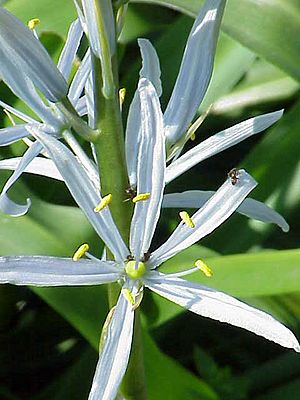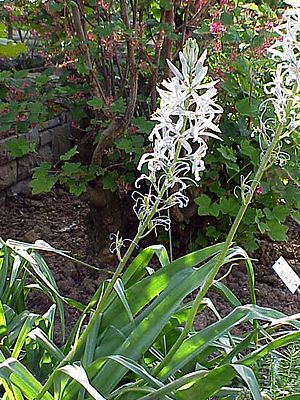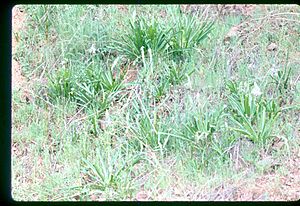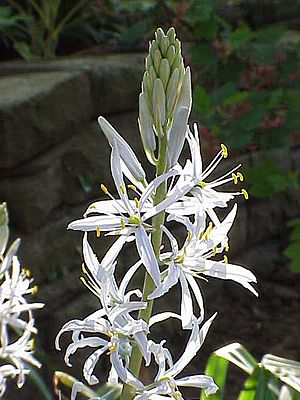Cusick's camas facts for kids
Quick facts for kids Cusick's camas |
|
|---|---|
 |
|
| C. cusickii | |
| Scientific classification |
The Camassia cusickii, also known as Cusick's camas, is a beautiful plant. It belongs to the Asparagaceae family, which includes many well-known plants. This plant grows naturally in parts of North America. People have been growing and selling Cusick's camas for about 30 years. There are about seven or eight types of camas plants in the wild, but only a few are commonly grown.
Contents
What Does Cusick's Camas Look Like?
Cusick's camas has long, thin leaves with straight veins. Its flowers usually have three parts. They are often ice blue or baby blue. Sometimes, you might see them in other shades of blue, cream, or white.
The flowers have a slightly uneven shape. Their petals, called tepals, dry up one by one after the flower opens. This plant has yellow parts called anthers. The seed pods are light brown and shaped like an egg. Wild flowers often have a deeper, darker blue color than those grown in gardens.
Where Does Cusick's Camas Grow?
You can find Camassia cusickii across North America. It is most common in the northwestern states, especially Oregon and Idaho. This plant likes damp meadows, often in higher areas.
It has been found in places like the Eagle Creek Mountains and Blue Mountains in Oregon. This plant is considered a "sensitive species" by some groups. This means it needs special care to protect it. You can find it in many different climates in Eastern Oregon.
What Kind of Home Does Cusick's Camas Like?
C. cusickii grows best in damp meadows. It likes places that are high up, between 4,000 and 6,000 feet (about 1,200 to 1,800 meters). It also grows well near ponds or in rich soil. It can bloom in both sunny and shady spots.
This plant usually flowers in May. Cusick's camas can easily grow from its own seeds. It just needs soil that is rich, moist, and drains water well.
How Does Cusick's Camas Grow?
C. cusickii grows from a bulb, which is like an underground onion. It has long leaves that grow from the base of the plant. The flowers grow in groups of three. The petals are usually pale blue, long, and thin.
The flowers grow on a tall stem, which can be up to 30 inches (about 76 cm) long. One stem can have as many as 100 flowers! The bulb of C. cusickii is two or three times bigger than the bulbs of other camas plants. However, it is not the tallest type of camas.
Scientists think that C. cusickii might have changed from another type of camas called C. quamash. This could be because of how plants mix their genes (hybridization) and how they get separated by geography.
Is Cusick's Camas Edible?
Native Americans did not eat this plant. The large root of Cusick's camas tastes bitter and can be slimy. This bitter taste comes from natural chemicals called saponins.
These saponins are being studied by scientists. They can help with research on other plant chemicals. C. cusickii is often confused with its close relative, C. quamash. Native Americans used to harvest the roots of C. quamash to eat them raw. They also boiled them to make a sweet, molasses-like treat.
How to Grow Cusick's Camas
C. cusickii likes soil that is rich and moist, but also drains well. The bulbs are usually planted about 6 inches (about 15 cm) deep. The best time to plant them is in late summer or early fall. You can also plant them later.
If you live in a very cold area, you should cover the soil with mulch in late autumn. This helps protect the bulbs. You can grow more camas plants by taking small bulbs that grow around the main one. Plant these small bulbs separately in the summer when the plants are resting.
Plants like Sweet William and Peonies grow well next to C. cusickii. You can plant Cusick's camas in flower beds, borders, or rock gardens. They also make good cut flowers for bouquets. This plant grows well with other perennial plants. C. cusickii can spread and cover the ground. Deer and rodents usually do not eat this plant.
How Did Cusick's Camas Get Its Name?
The name 'quamash' comes from Native American words for a similar plant. There is also a beautiful dark blue type of this flower called 'Zwanenburg'. This name comes from a famous bulb nursery in Haarlem, Netherlands.
The botanist Sereno Watson is known for naming this plant. He likely named it while collecting plants during a big survey of the western United States. This survey was called the "U.S. Geological Exploration of the Fortieth Parallel" and happened from 1867 to 1871. Watson first officially wrote about C. cusickii in 1888 in a journal called Garden and Forest.
Sometimes, C. cusickii is confused with wild hyacinth. However, botanists say that its close relative, Camassia scilloides, is the plant truly known as wild hyacinth.




